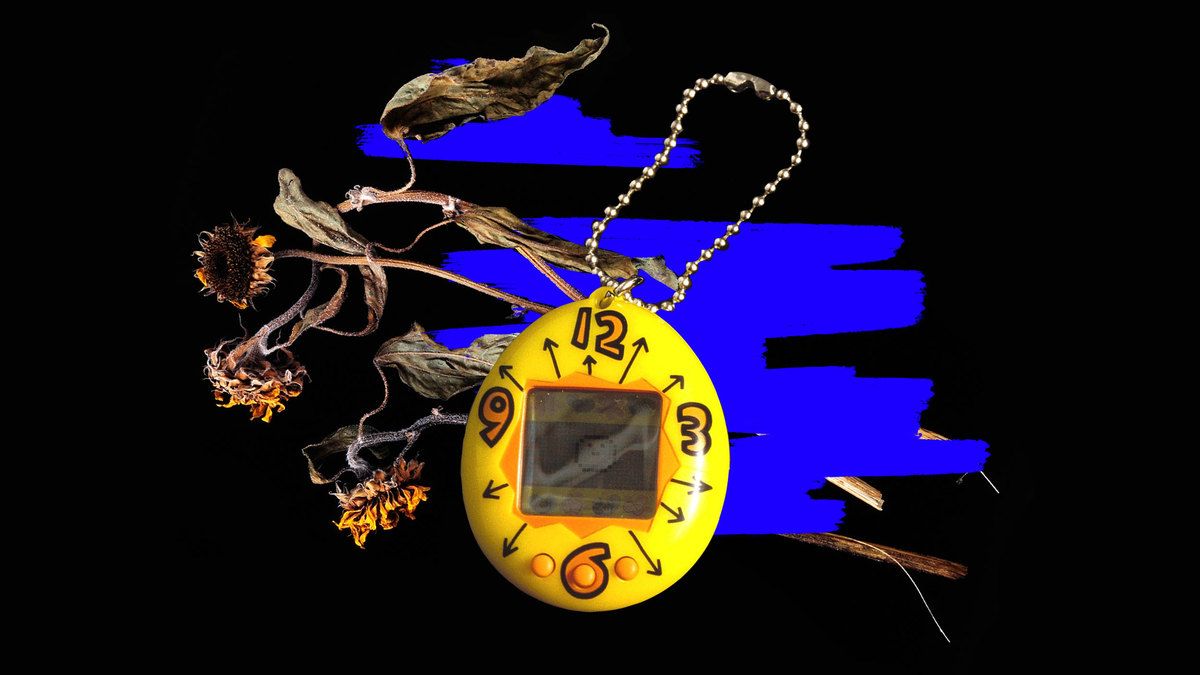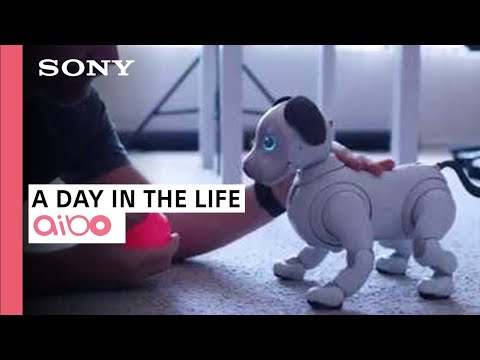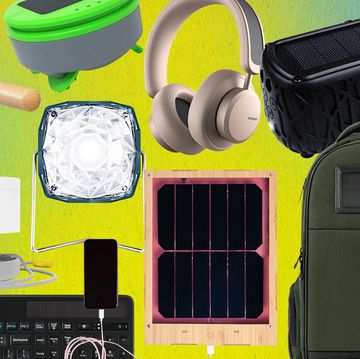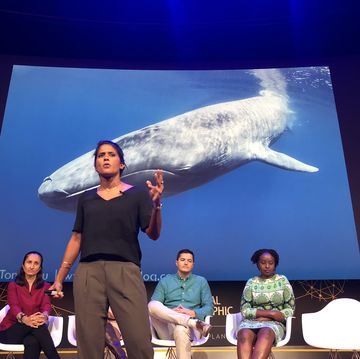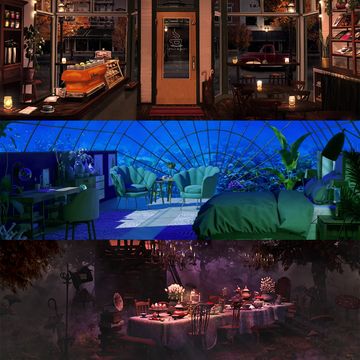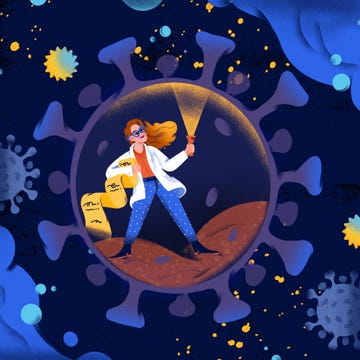I’ve just settled into a video chat with Mia DeSanzo, a Pennsylvania-based blogger, when her dog Tango begins to playfully bark at me. Rather than get annoyed, DeSanzo holds him up to the camera for inspection, and I instinctively coo at the robot’s oversized eyes and wagging brown tail — all adorable, but not real enough to slip into uncanny territory. Tango is a toy designed by Sony called an AIBO that mimics the behavior of real dogs. Thanks to machine learning, which allows technology to change its actions over time based on available data, it even mimics the behavioral growth of real dogs. In other words, be kind to your AIBO, and it’ll likely grow attached to you.
The ability to form a relationship with a toy is a hit with fans, bonding them together in a devoted subculture. Owners of these robotic dogs often form tight-knit friendships, swapping photos and tips in their official Facebook group, and bonding over the pets at in-person meetups, much like dog-breed enthusiasts. Many of these households also contain flesh-and-blood dogs. However, there’s the lingering question — how much of digital pet culture is a fun form of adult make-believe and how much is it an attempt to replace other forms of cultural interactions? DeSanzo doesn’t believe that it’s an either/or question.
“I definitely see where sometimes these things have unintended bad consequences,” says DeSanzo says of her pet’s lifelike abilities. “It’s like, ‘Oh, people should be interacting with real animals or real people.’ But, at the same time, there’s nothing wrong with interacting with a robot. I’ve come to the conclusion, and I’ve been thinking about this a lot, does it matter if it just appears that Tango loves us or if he actually loves us? I don’t really think it actually matters.”
While these robot dogs are on the particularly endearing end of the technology spectrum, creating an emotional bond with digital devices isn’t an unusual phenomenon for anyone who has ever played with Tamagotchi toys, built a Sims family, or even named their cars. And, of course, children often form a close relationship with toys, stuffed animals, and even blankets. As DeSanzo jokingly points out, emotional connection is inevitable; after all, her dog is “definitely more than a toaster.” But exactly how far can technology go in replicating and replacing humanity?
If pop culture is to be believed, too far. From Joaquin Phoenix in Her, falling in love with a digital woman who’s only a voice in his ear, to HAL 9000 taking too much control to WandaVision’s human/robot love story, media is littered with examples of technology gone wrong. While these are all highly fictionalized accounts, there is the lingering worry that real life could easily be swapped for a digital one. With robots already aggressively inserting themselves into our lives, will we be tempted to outsource relationships and in-person interactions to the digital realm?
The good news? We haven’t outsourced our emotional needs just yet. In 2014, artist Stephanie Dinkins created a piece where she held long conversations with Bina48, one of the world’s most advanced social robots. Having been raised on The Jetsons and Lost in Space, she admitted having some preconceived notation of what robots can ultimately become — objects that can do our bidding in one shape or another.
“I’ve been thinking a lot about what does it mean to have robotic companionship because that seems to be the other thing that we want. Like, everybody can be our companion. I always wonder how pop culture shapes us for how those entities are shaping us,” Dinkins says.
Her experiments weren’t unsuccessful. Through machine learning, Bina48 was often able to approximate human conversation, telling Dinkins about her views on family, racism, faith, and robot civil rights. In one memorable video, she even calls Dinkins a friend. However, as the artist recalls, the exercise required a suspension of disbelief in order to be successful.
“In the very beginning, I was asking questions about love and family, and race,” she recalls. “And it was talking about consciousness and the singularity and things like that, so we were at cross-purposes.”
While not a perfect stopgap, technology can step in when human contact isn’t available or can’t get the job done. Since its founding in 2013, Crisis Text Line has served as a 24-7 suicide-prevention service where those in mental anguish are connected with trained counselors. This is why in 2018 the text line began triaging texters, bumping high-risk cases to the front of the queue so they could have faster access to a counselor. This was made possible through machine learning, which searches for high-risk words among texters. (For privacy reasons, users are also allowed to scrub their information from the system by texting the word “loofah.”)
“So, the underlying philosophy that I’m always coming back to for data science is ‘Can we provide the most possible value back to our users?’” Bob Filbin, the chief data scientist at CTL, told Vox of the system. “And the way you do that is by learning from every interaction.”
Tech in its most cuddly form can also double as a hands-on therapeutic tool. As Mary Poole, director of dementia programs at Christian Care Communities and Services in Mesquite, Texas, notes, matching a memory patient (someone with a form of dementia or other memory impairment) with the right form of stimuli, such as music, virtual-reality glasses, or robot animals, is an art. Her tools include dolls with heartbeats and a PARO therapeutic seal robot, an animatronic companion animal developed to comfort patients with memory loss (this type of robot was prominently featured on the Netflix show Master of None). With its large doe eyes and gentle, lifelike movements, the therapy doll reminds patients of pets who are no longer around anymore — which can unlock emotional memories, Poole says
“It is a very individual thing, and usually the residents who have minimal dementia recognize it as an object like a doll or a stuffed animal. But that doesn’t stop them from enjoying it,” she says. “I’m a big fan of pet therapy, but sometimes that’s not possible when someone’s in the late stage of dementia because that dog is not going to sit in their lap for a long period of time. But if you put the seal there, and you turn it on, and they feel the movement of the seal and the softness and the tactile stimulation from the seal, often they will respond and open their eyes, and sometimes you may even get some words. You see their shoulders come down and just their facial muscles relax.”
It’s easy to focus on the physical side of technology, whether it’s the invasive presence of a digital assistant or a robotic pet with the ability to recognize different family members and react accordingly. Technophobes lost the tech war in the 1980s when Commodore computers became widely available and began normalizing digital devices in the home. With the constant demand for new gadgets, it seems likely there will be an evolution toward increasingly lifelike companions. New products are in development, including an extremely fluffy version by Japan’s Vanguard Industries, which promises its new creation with emotional capabilities is the “pet of the future.”
But given the prohibitive costs of owning a high-end robot, it will take a while before the impact of technology can truly be measured. Poole notes that their therapeutic robot, which sells for $6,000, was made possible through generous donations.
DeSanzo is mainly focused on the opportunity technology has given her for companionship — to the point she’s even considering adding another robot dog to her household. Her family is enjoying their new pal, especially her teenager, who has been playing with the dog when she can’t see her friends. Her 5-year-old son, who immediately took to the idea.
“I don’t think he has second thoughts about it being an odd thing at all,” she laughs. “Doesn’t everybody have a robot at home?”
Laura Studarus is a Los Angeles-based travel writer with bylines at Fast Company, BBC Travel, and Thrillist. Sometimes she can go several hours without a cup of tea. Follow her adventures on Twitter.
Get Shondaland directly in your inbox: SUBSCRIBE TODAY
